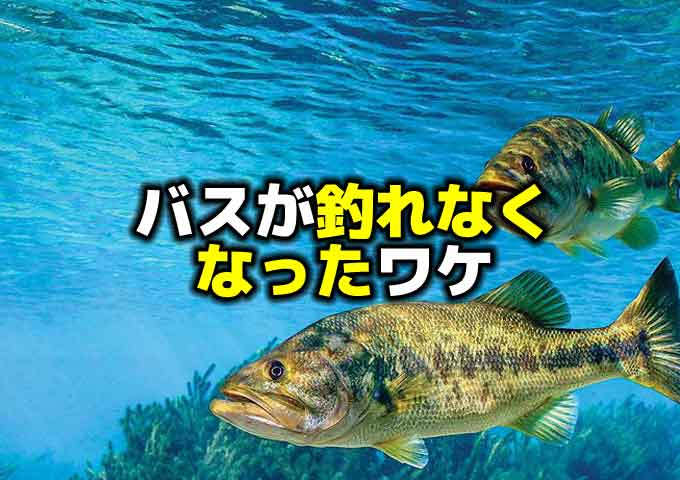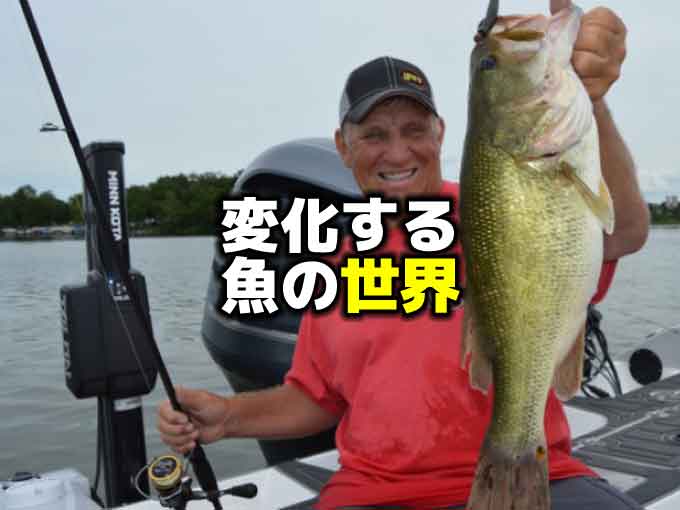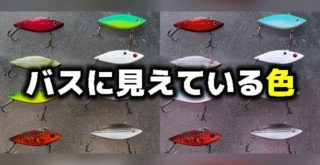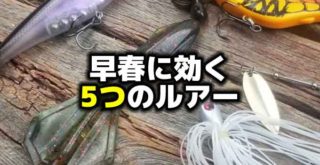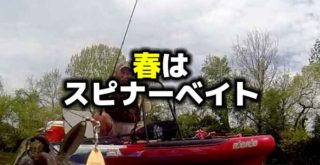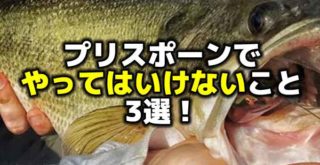ラージマウスバス釣り入門

Photo by worldfishingnetwork.com
こんにちは!店長の小山です!
本日は海外サイトより、”Largemouth Bass”という記事を引用してご紹介いたします。
引用先:worldfishingnetwork.com”Largemouth Bass”Posted Mar 14, 2000(海外サイトです)
ブラックバスという言葉、これがまた不思議なもので、私が住んでいる地域でバスと言えばスモールマウスバスなんです。長野県を上からだいたい3等分した時の呼び方を「北信」「中信」「南信」などと呼ぶのですが(信は信州・信濃の信です)、私の住んでいる北信地方のブラックバスを全部ひっかき集めた時、おそらくスモールの方が多いと思うんですね。
しかし、ブラックバスと言えばイメージするのはまずラージマウスバスなんです。私のイメージですけども。
ブラックバスという魚の存在を知ったのは小学校5年くらいだったか、「釣りキチ三平」というコミックの中で知りました。それから小学館の「ルアー釣り入門」などを買って読んでは出かけてみましたが、当時の自分の行動範囲にはバスは住んでいなかったと思います。
ルアーはそのころはスプーンやスピナーを適当に買っていたか、行動範囲のお店にはバス用プラグがなかったので、「学研釣りトップ」の裏表紙にあるのコーモランの通販で「どじょっこ」や「かへるくん」、クレイジークローラーっぽいノイジーを買ったこともありました。クレイジークローラーっぽいルアーの名前は忘れましたが、たしかファーフィニッシュで尻尾もあったような記憶があります。そして当時は金額分の切手でも通販で買えた覚えがあり、親に内緒で郵便局で切手を買い、通販でルアーを買ったと思います。
それから社会人になって初めてラージマウスを釣るまでの数年間、ずっとまだ見ぬ怪魚、ブラックバスというアメリカの魚を「いつか釣りたい」と思っていたことが、ブラックバス=ラージマウスという私のイメージを根付かせているのだと思います。
これを読んでいる方の中にもこれと似たような境遇の方はいらっしゃるかもしれませんし、物心ついた時からブラックバスが身近にいるという方もいらっしゃるかと思います。逆に、同じような理由でブラックバス=スモールマウスという方もいらっしゃるでしょう。
世代や環境の違いから、スタート地点に差はあるかもしれませんが、今こうしてバス釣りがもっと上手になりたい、もっとバスのことを知りたいという気持ちにはそれほど差はないのかもしれませんね。
この記事は、北アメリカを中心とするフィッシングメディア「World Fishing Network」の1ページをご紹介するもので、記事は2000年に書かれたものです。これからもどんどんアメリカのヤングバスフィッシャーマンたちが誕生していく事と思いますが、そんな彼らもこういった記事に辿り着くのでしょうか。
国境と世代を越えたラージマウスバス入門、ぜひ読んでみて下さい。
ラージマウスバスの他の名称
Black bass, bucketmouth, widemouth, green bass, green trout, widemouth bass.
ブラックバス、バケットマウス、ワイドマウス、グリーンバス、グリーントラウト、ワイドマウスバス。
ラージマウスバスの外観
The largemouth bass is a heavy-bodied fish typically olive-green in color, with shades of brown. Dozens of dark, oval blotches mark all along the side of the fish, forming a jagged horizontal line. Unlike smallmouth bass, a largemouth’s upper jaw extends beyond the eye.
ラージマウスバスは非常に重い身体を持つ魚で、基本的にはオリーブグリーンカラーから茶色に変化する色調を持っています。 数十点の暗い楕円形の斑点が、魚の側面に沿って並び、ギザギザの横線を作っています。 スモールマウスバスとは異なり、ラージマウスの口の端は目の位置より後ろまで伸びています。
最大サイズ
North American bass tend to grow between 10-30 inches (25-76 cm), depending on the area. Warmer lakes produces larger bass than northern bodies of water. On average they rarely exceed 10 pounds (4.5 kg), but the maximum recorded bass weighed 25 pounds (11.3 kg). In certain parts of the world, such as Japan, largemouth bass are an invasive species, and therefore grow to greater sizes than average given their lack of predators.
北アメリカのバスは、湖の面積に応じて10-30インチ(25-76 cm)の間で成長する傾向があります。 暖かい湖は北部のフィールドよりも大きなバスを生み出します。 平均して10ポンド(4.5 kg)を超えることはほとんどありませんが、最大重量は25ポンド(11.3 kg)です。 日本などの世界の特定の地域では、ラージマウスバスは侵略的な種であるため、ラージマウスバスを捕食する者が不足していることから、平均より大きなサイズに成長します。
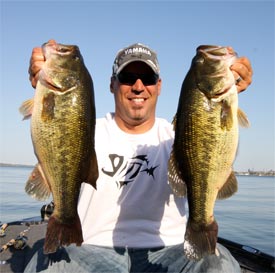
Photo by worldfishingnetwork.com
生息範囲
They are native to eastern United States and southern Canada but have been introduced throughout the North American continent where it’s warms and many places around the world.
彼らは東アメリカとカナダ南部の出身ですが、北アメリカの暖かい地域や世界中の多くの場所で生息しています。
生息地
Largemouths thrive in lakes, ponds, and reservoirs that are shallow, with lots of cover and generally a muddy bottom floor. Weedbeds are a favorite for largemouth as they provide both protection from predators and cover for hunting prey. However, largemouth bass have adapted to live in many different kinds of habitats, including clear and rocky lakes and rivers with currents.
ラージマウスバスは、湖沼、池、リザーバーの各シャローで多くのカバーがあり、一般的には泥底で育ちます。 ウィードベッドは、捕食者から身を守るためと捕食のためのハンティングの両方に利用できることから、ラージマウスのお気に入りです。 しかし、ラージマウスバスは、岩の多いクリアレイクや流れのある川など、あらゆる種類の生息地に適応できます。
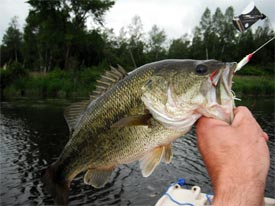
Photo by worldfishingnetwork.com
寿命
On average bass live to see 15 years, with rare recorded exceptions exceeding 20 years of age.
平均的なバスの寿命は15年、例外として20年を超える珍しい記録を見ることもあります。
食べ物
In short, anything small enough it can swallow. Panfish like blugill and sunfish are a favorite treat, but anything from worms, frogs, snakes, crayfish, bats, water birds, mammals, and more.
一言で言えば、小さいものはなんでも飲み込んでしまいます。 ブルーギルやサンフィッシュのようなパンフィッシュが好きですが、ミミズ、カエル、ヘビ、ザリガニ、コウモリ、水鳥、哺乳類などなど、色々なものがあります。(パンフィッシュ=フライパンにぴったり収まるような平べったい形の魚のあだ名)
産卵
Largemouth bass spawn in the spring when temperatures rise above 60° F (15.5° C). Spawning grounds vary from gravelly sand to soft mud in reeds. Males guard the nest and continue to protect the young for the first month after hatching.
春になり水温が15.5°Cを超えるとラージマウスバスは産卵します。 産卵地は、砂砂利からアシ際の柔らかい泥底まで様々です。 オスは巣を守り、孵化後から1ヶ月間、稚魚を保護し続けます。
バスを食べるもの
Juvenile bass fall prey to walleye, northern pike, and muskie. As bass grow bigger, predation becomes much less of an issue, though a large muskie will always pose a threat.
Credit for information above: Fisheries and Oceans Canada and Alabama Department of Conservation and Natural Resources.
小さなバスは、ウォールアイ、ノーザンパイク、マスキーの餌食になります。 バスが大きくなるにつれて、大きなマスキーには常に狙われるものの、食べられることは非常に少なくなります。
上記の参考資料:カナダとアラバマ州漁業と海洋保全および天然資源省。
バスフィッシングが特別である理由
The most popular target for freshwater anglers in North America is the largemouth bass, especially in the United States. A big reason for this is the sheer abundance of the species, as it can be found in ponds, lakes, and rivers in great numbers throughout much of the continent. For stocking purposes, largemouths can easily adapt to many different styles of lakes and can coexist with many different species without causing too much of a negative environmental impact. Certainly its desired habitat is warmer waters with plenty of vegetation, cover, and shallow depths, but a clear, rocky lake can still support a healthy largemouth population.
What really drives the largemouth bass’ popularity is the sheer joy it is to reel in a lunker. Bucketmouths have a well-deserved reputation for being a tough and entertaining fighter. They’re head-shakers that’ll go so far as jumping out of the water in an attempt to get free. Moreover, largemouth bass love to go after artificial baits so much that live bait is pretty much never required, unlike other species of fish like catfish and even walleye.
The fun also lies in the thrill of the hunt. Sure they’ll go after any number of lures and baits, but it’s finding out which pattern and technique is the right one for the right time that’ll really get you results.
Finally, anyone can fish for largemouth bass. You don’t have to have a bass boat with a huge motor and all the latest gear to catch a bass (though they certainly help get you better results). A child fishing off shore can have just as much luck as anyone from a boat if the conditions are right as largemouths are relatively easy to catch in comparison to other species of gamefish.
アメリカ合衆国、特に北アメリカの淡水釣り魚で最も人気のターゲットはラージマウスバスです。大きな理由としては、大陸の多くの地域の池、湖沼、川に数多く見られる種がもたらす圧倒的な量です。放流・養殖の目的では、ラージマウスはさまざまな湖に容易に適応でき、環境への悪影響をあまり引き起こさずに多くの異なる種と共存することができます。確かに望ましい生息地としては、ウィード、カバー、シャローのある温暖な水ですが、岩場のクリアレイクであっても、健康なラージマウスの個体群は育つことができます。
ラージマウスバスの人気を支える本当の理由は、ランカーを釣り上げた時の喜びです。 バケットマウスはタフで、ファイトを存分に楽しませてくれるという評判が高いためです。彼らは自由になるために水から飛び出すほどジャンプし頭を振るヘッドシェーカーです。さらに、ラージマウスバスは、疑似餌を追いかけるのが大好きで、ナマズやウォールアイなどの他の魚種とは異なり、生きた餌をほとんど必要としません。
楽しさはまた、ハンティングとしてのスリルにもあります。確かに彼らはルアーやエサをなんでも追いかけますが、実際にはしっかりと結果をもたらすには適切なタイミングとパターンとテクニックを探さなければなりません。
最後に、誰もがラージマウスバスを釣ることができます。巨大なエンジンを搭載したバスボートや、最新のタックルでバスを釣る必要はありません(それらは確かに釣るために役立ちますが)。ラージマウスバスを釣るのが他のゲームフィッシュより比較的簡単な状況であれば、子供だろうが沖のボート上の誰にもチャンスがあります。
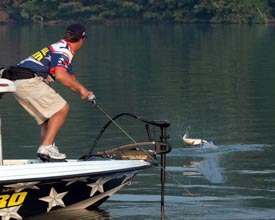
Photo by worldfishingnetwork.com
ラージマウスバスを釣る人気の方法
There are many ways to catch a bass, but the methods below are used the most, and for good reason – they work. Master these techniques to maximize your performance as a bass angler.
バスをキャッチする方法はたくさんありますが、以下の方法が最も多く使われています。 これらのテクニックを習得して、バスアングラーとしてのパフォーマンスを最大限に高めましょう。
ピッチング/フリッピング
When bass are not all that active and are hiding in thick cover, it’s as if you have to go into stealth mode to catch those shy lunkers. The best methods for getting to thick, shallow water without spooking fish too much are pitching and flipping. They are similar looking techniques, but some occasions require one over the other, especially as it pertains to distance. The key to successful pitching/flipping is practice, a long rod (6.5’-7.5’), and the right soft bait.
Pitching
Pitching is the easier of the two, but is not as precise as flipping. Let out enough line so it’s about even with the reel, and keep your reel open. Lower the rod tip towards the water and with your free hand, grab hold of the lure (worm and tube jigs work best) and pull on the line to add tension. In one smooth motion let go of the lure while swinging your rod tip up. This combination should slingshot the bait towards your target. Be sure to close the reel as soon as the bait lands because bass often strike quickly.
Flipping
Flipping takes more practice, but once you get a good feel for it, you can optimize your presentation and hit your target location more precisely than pitching. Begin by letting out somewhere between 8-15 feet of line and then close your reel. Grab the line between the reel and first rod guide, and then extend your arm to the side as you pull on the line. Raise the rod and the bait will now swing towards you. Using a pendulum motion swing the bait to your desired location while feeding the line through your hand. Tighten up the remaining slack and get ready for a strike. It looks a little awkward, but it’s a great way to get a drop on some shy bass.
バスがアクティブな状態ではなく、濃いカバーに隠れている場合、ステルスモードに入って臆病なランカーを捕まえなければならないようです。その濃いシャローカバの臆病者を釣るための最良の方法は、ピッチングとフリッピングです。これらは見た目は似たようなテクニックですが、使う機会としては距離に応じてどちらか一方を使うといいでしょう。ピッチング/フリッピングを成功させる鍵は、練習、ロングロッド(6.5′-7.5 ')、そして正しいワームです。
ピッチング
ピッチングは2つうちの簡単な方ですが、フリッピングほど正確ではありません。リールのあたりにルアーが来るようにラインを出しておきます。リールはフリーにしておきます。ロッドの先端を水面の方に下ろし、ラインテンションを掛けたまま片方の手でルアーを持ってください(ジグにワームやチューブを付けるとやりやすいです)。ロッドティップを上に振りながらルアーを放す、これを一連のスムーズな動きでおこなってください。このとき、ターゲットに向かってルアーを滑らせるように行ってください。バスがすぐに喰ってくる可能性があるので、ルアーが着底したらすぐにリールをオンにする(クラッチを入れる・ベイルを返す)ようにしてください。
フリッピング
フリッピングにはより多くの練習が必要ですが、一度感触を覚えたら、プレゼンテーションが最適化され、ピッチングよりも正確にターゲットに当てることができます。まずラインを2.4〜4.5メートルの間ぐらいで出しておいて、リールを閉じます(クラッチオン・ベイル返し)。リールと1つ目のロッドガイドの間のラインをつまみ、腕を横に伸ばしてラインを引っ張ります。ロッドを上げることで、ルアーが自分に向かって戻ってきます。振り子の要領でルアーを送り出し、あなたの手の中を通るラインを調節しながら狙った場所へ落とします。残りのスラックを巻取り、バイトに備えてください。少し難しいように聞こえますが、それは臆病なバスを釣るための素晴らしい方法です。
トップウォーター
For many anglers there’s nothing more exciting than catching a bass with a surface lure. Unlike pitching or flipping, topwater lures are meant for hungry, active fish. There are several kinds of surface lures, like poppers, jitterbugs, and frogs. Some topwater lures are easy and work best with a slow, steady retrieve, like a jitterbug. Others take some more technique. The aptly named ‘popper’ requires an angler to literally pop the lure as it is retrieved, pausing every few seconds and allowing it to go steady, imitating a wounded fish. The sporadic stopping and moving can drive bass crazy. Another popular retrieving method is called ‘walk the dog,’ commonly used for soft surface frog baits. Walking the dog is where you quickly twitch the rod tip up and down for the duration of the slow retrieve.
多くの釣り人にとって、トップウォータールアーでバスを釣ることほどエキサイティングなことはありません。 ピッチングやフリッピングとは異なり、トップウォータールアーは空腹の活発な魚を釣ることを意味します。 ポッパー、ジッターバグ、フロッグのように多くのトップウォータールアーがあります。 多くのトップウォータールアーは簡単で、ジッターバグのように、ゆっくりとしたステディリトリーブで最も効果を発揮します。 テクニックが必要なものもあります。 「ポッパー」という名にふさわしいルアーは、回収されるまでの間に文字通りルアーをポップし、数秒ごとにポーズし、弱った魚を模倣することを釣り人に要求します。 散発的な停止と移動により、バスが狂ってしまうことがあります。 もう一つの一般的なテクニックは「ドッグウォーク」と呼ばれ、一般的にはフロッグルアーに使用されています。 ドッグウォークは、ゆっくりとリールを巻きながら、ロッドティップを素早くトゥイッチするとできます。
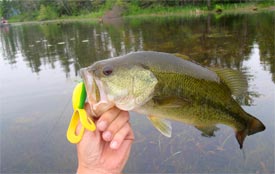
Photo by worldfishingnetwork.com
クランクベイト
A crankbait is all about reflex for a bass. They won’t want to chase it down the same way they would for a surface lure, but even so, noise and presentation is still key to using a crankbait right. Crankbaits are a favorite for many tournament anglers because they cover a lot of water, both horizontally and vertically at a variety of depths. They work best around solid objects, like rocks, logs, and stumps. It is possible to use a crankbait along the side of a weedbed, but generally drop-offs and rocky shoals with plenty of solid cover works best. The more you get to know the feel of the way your crankbait swims through the water and bumps into objects the better you will be at catching bass.
クランクベイトは、バスに反射させるものです。 彼らはトップウォータールアーと同じように追いかけてくることはありませんが、それでもクランクベイトを使うにはノイズとプレゼンテーションが重要です。 クランクベイトは、様々な深度で水平方向と垂直方向に対してアピールできるため、多くのトーナメントアングラーに好かれています。 彼らは、岩、木、スタンプのようなハードカバーの周りで最もうまく機能します。 ウィードベッドのエッジに沿ってクランクベイトを使用することも可能ですが、一般的にはドロップオフや砂や岩底のハードカバーが多く入った場所で機能します。 クランクベイトが水中を泳ぎ、物にぶつかるような感じが増すほど、より良いバスを捕まえることができます。
スピナーベイト
Spinnerbaits are a great year-round lure that can produce results on any given day on any given lake. Retrieval should range from slow to medium speed, and like the crankbait, works best around some solid structure. There are several different ways to use this versatile lure. One method is to allow the spinner bait to fall to the bottom near a drop off. As it hits bottom, reel up the slack, then allow it to fall to the bottom again. Repeat. For the most part, however, you’ll be reeling in continuously at different paces. The slower you reel in, the deeper the bait tends to swim through the water. When you reel in at a faster rate, try to not to breach the surface. Hanging just below will create a wake that some fish will find irresistible.
スピナーベイトは、一年中使用できる魅力的なルアーであり、いつでも、どんな湖でも釣果を得ることができます。 リトリーブは、スローからミディアムスピードにする必要があり、クランクベイトのように、ハードストラクチャー周りに最適です。 この多目的なルアーを使用するにはいくつかの方法があります。 1つの方法としては、スピナーベイトをドロップオフの近くにフォールさせることです。 ボトムに着いたらたるみを取ってから、再びボトムまでフォールさせる、これの繰り返しです。 しかし、ほとんどの場合、色々な速さでリトリーブし続けます。 ゆっくりとリーリングするほど、ルアーはより深いレンジを泳ぐ傾向があります。 速い速度でリールを巻くときは、水面から飛び出さいないようにしてください。 ちゃんと釣るには魚が我慢できなくなるような速さを見つけ出すことでしょう。
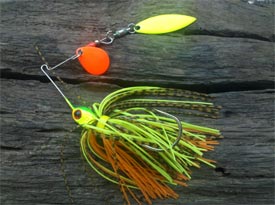
Photo by worldfishingnetwork.com
ジャークベイト
Possibly the simplest technique for bass fishing and certainly the easiest to pick up is jerkbait fishing. The hard part is knowing what jerkbait to use and when to use it. The lures come in many shapes and sizes that swim at varying depths, but no matter how different they may be, the goal remains constant: imitating a wounded fish. As the name implies, jerking the rod tip with a little twitch as you reel in gives the impression that your jerkbait isn’t swimming at full health. Bass love an easy meal, and that’s what you’re tying to mimic. Jerkbaits are best reserved for clear waters as sight is the most important factor for success with this technique.
おそらく、バスフィッシングの中で最もシンプルで、最も簡単に釣れるテクニックはジャークベイトです。 難しい部分とすれば、使うジャークベイトとそれをいつ使うかを考えることです。 ルアーには様々な形、サイズ、泳ぐレンジがありますが、どのような種類があったとしても、それが果たす役割はひとつ。傷ついた魚を模倣することです。 その名前が意味するように、リールを巻きながらロッドティップを少しトゥイッチすると、ジャークベイトは完全に健康な状態で泳いでいないという印象を与えます。 バスは簡単な食事が大好きで、それはあなたが模倣しているものです。 ジャークベイトのテクニックを成功させるためには、視界の良さが最も重要な要素であるため、クリアウォーターのフィールドが最も適しています。
ダウンショットリグ
This finesse form of fishing takes a little more effort to rig up than the others, but it’s a crucial technique nonetheless and should be a part of any serious bass angler’s repertoire. If you’ve fished with a plastic worm, then you can adapt quite quickly to dropshotting. The major difference is that the weight is below the worm – as you reel up the worm and work its magic, the sinker bounces along bottom, leaving your worm several inches up, free for the taking. The length between the worm and sinker can range anywhere from a few inches up to a foot-and-a-half, it all depends on how high you want the bait suspended from bottom. Unlike the other techniques mentioned here, the retrieval isn’t what’s important. The key is moving your rod tip in a way to make your bait dance as enticingly as possible.
このフィネスフィッシングは、他の釣りよりも手間がかかりますが、重大なテクニックであり、真剣にバスを釣りたいアングラーのレパートリーのひとつになることでしょう。 ワームを使って釣ったことがあるなら、すぐにダウンショットリグに適応することができます。 主な違いは、シンカーがワームの下にあることです。ワームを引っ張ることでワームがフリーの状態から動きだし、ワームは数センチ跳ね上がり、シンカーはボトムに沿って跳ねまわる、まるで魔法のような動きをします。 ワームとシンカーの間の長さは、数センチから45センチほどまでさまざまですが、いずれにしてもワームをどれくらいの高さにしたいかによって決まります。 ここで述べた他のテクニックとは異なり、サーチは重要なものではありません。 キーはロッドティップを動かしてワームをいかに魅力的に踊らせることができるか、ということです。
バスフィッシングトーナメント
The most popular tournaments with the highest payouts for tournament fishing in North America involve bass, with largemouth being the number one target. Pro tournament fishing is a big business in the United States, backed up by dozens of smaller tournament series, like the American Bass Anglers or Skeeter Bass Champs. Below is some more detailed information on two of the biggest bass fishing tournament organizations in the world.
北米で高い賞金が出る人気のバス釣りトーナメントは、ラージマウスがナンバーワンのターゲットになります。 プロトーナメントの釣りはアメリカではビッグビジネスであり、「アメリカンバスアングラー」や「スキーターバスチャンプス」のような数多くの小さなトーナメントシリーズに支えられています。 以下は世界で最も大きな2つのバスフィッシングトーナメント団体の情報です。
B.A.S.S.
Certainly the most popular tournament organization in the U.S. is B.A.S.S. (Bass Anglers Sportsmen Society), a mulit-billion dollar fishing industry that hosts several successful tournament series – Federation, Bass Pro Shops Opens, Weekend Series, and College, for example. The biggest and brightest of them all, however, is the Elite Series. Many of the world’s top anglers compete for a top-prize paycheck of $100,000 per tournament. Perhaps most important of all, however, is that Bassmaster plays host to what many consider the Super Bowl of bass fishing: the Bassmaster Classic. A field of just 50 anglers compete for the top prize of $500,000 and a title that is the most revered in tournament fishing anywhere.
米国で最も人気のあるトーナメント組織はB.A.S.S.(Bass Anglers Sportsmen Society)で、フェデレーション・ネイション、バスプロショップス・オープン、ウィークエンド・シリーズ、カレッジ・シリーズなどのトーナメントシリーズを成功させ10億ドルの釣り産業となっています。 しかし、その中で最も大きくて最も豪華なのは、エリートシリーズです。 世界の一流の釣り人の多くは、1試合1万ドルの最高賞金を競い合います。 しかし、おそらく最も重要なことは、バスマスターが、バスフィッシング界のスーパーボールであるバスマスタークラシックを開催することだと考えていることです。 たった50人のアングラーが、500,000ドルの最優秀賞と、どのトーナメントよりも賞賛されるタイトルのために競い合います。
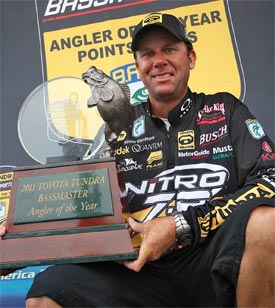
Photo by worldfishingnetwork.com
FLW Outdoors
B.A.S.S. may have the history, prestige, and the world’s most cherished fishing tournament, but the title of the most lucrative tournament organization belongs to FLW Outdoors. Coming to fruition less than two decades ago (1996), FLW Outdoors now boasts more tournaments than any other organization – as many as 191 in 2011 when factoring competitions for other species, such as walleye – and offers more money per competition than even B.A.S.S. The headlining series is the Walmart FLW Tour, where top professional anglers compete for a top prize of over $100,000, much like the Bassmaster Elite tournaments. FLW Outdoors’ equivalent of the Bassmaster Classic is the Forrest Wood Cup. The main differences between the two juggernaut tournaments is that the Forrest Wood Cup not only offers a larger top prize ($600,000), it also runs a competition for co-anglers, whereas in the Classic pros fish alone.
B.A.S.S.は歴史と名声において世界で最も尊敬される釣り大会があるかもしれませんが、最も大切なトーナメント組織のタイトルはFLW Outdoorsに属します。 20年以上前(1996年)に実現したFLW Outdoorsは、他のどの組織よりも多くのトーナメントを誇り、ウォールアイなど他の種の競技を入れると2011年には191個もの大会があり、賞金額はB.A.S.S.を越えます。最大の大会は、ウォルマートFLWツアーです。トッププロの釣り人は、バスマスター・エリートトーナメントのように、$ 100,000以上の優勝賞金を競います。 バスマスタークラシックに相当するFLW Outdoorsの大会はフォレスト・ウッド・カップです。 2つの大規模なトーナメント団体の主な違いは、フォレストウッドカップがより大きな優勝賞金($ 600,000)を提供するだけでなく、コ・アングラー(同船者)も競技に含めますが、バスマスタークラシックではプロが1人で釣るだけです。
いかがでしたか。
アメリカのバス釣り入門書には、トーナメントのことまできっちり載っていて、優勝賞金額まで明らかにされているんですよね。
バス釣りでアメリカナンバー1になれば、賞金50万ドル(約5千万円)が手に入る。これは夢があります。
バスプロになりたいという若者は、私の時代の頃より多くなりました。そういう夢や目標を口にするのは素晴らしいことだと思いますし、それはお金が目的でも全然いいと思います。夢であり、現実です。
またそれと同時に、かつての私のように、よくわからないルアーを買っては、試行錯誤し、下手くそながらも1匹を目指してなんとなく続ける、これもまた悪くないと思います。あのころコーモランのどじょっこやかへるくんを切手で通販で買って遊んだ思い出は今もずっと残っているわけで、大切な思い出なんですからね。(当時はべつに思い出にしたくてやってたわけじゃないですけどね)
初心者の方にとっては釣れなくて苦しい期間はあるかと思いますが、ぜひある程度思い通りにバスが釣れるようになるまで、あせらず続けてもらいたいと思います。
他人と比べるとつまらなくなる場合もありますので、ぜひ自分が釣りたいと思う方法や道具を使って、楽しんで行ってください。
バス釣りは世代や国境を越えて楽しめる、素晴らしいものだと思います。
それでは、また。
毎度ありがとうございます!









